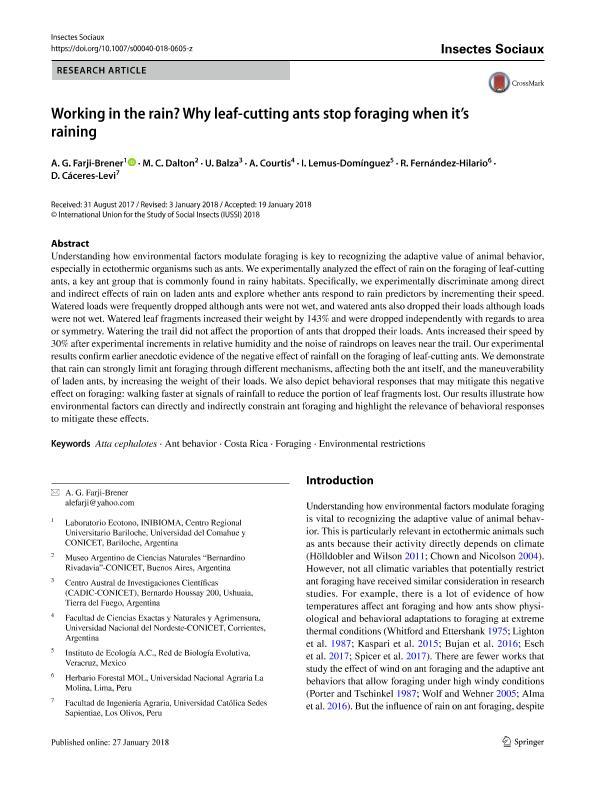Mostrar el registro sencillo del ítem
dc.contributor.author
Farji Brener, Alejandro Gustavo

dc.contributor.author
Dalton, María Cecilia

dc.contributor.author
Balza, Ulises

dc.contributor.author
Courtis, Azul Celeste

dc.contributor.author
Lemus Domínguez, I.
dc.contributor.author
Fernández Hilario, R.
dc.contributor.author
Cáceres Levi, D.
dc.date.available
2019-10-18T19:03:42Z
dc.date.issued
2018-05
dc.identifier.citation
Farji Brener, Alejandro Gustavo; Dalton, María Cecilia; Balza, Ulises; Courtis, Azul Celeste; Lemus Domínguez, I.; et al.; Working in the rain? Why leaf-cutting ants stop foraging when it’s raining; Birkhauser Verlag Ag; Insectes Sociaux; 65; 2; 5-2018; 233-239
dc.identifier.issn
0020-1812
dc.identifier.uri
http://hdl.handle.net/11336/86446
dc.description.abstract
Understanding how environmental factors modulate foraging is key to recognizing the adaptive value of animal behavior, especially in ectothermic organisms such as ants. We experimentally analyzed the effect of rain on the foraging of leaf-cutting ants, a key ant group that is commonly found in rainy habitats. Specifically, we experimentally discriminate among direct and indirect effects of rain on laden ants and explore whether ants respond to rain predictors by incrementing their speed. Watered loads were frequently dropped although ants were not wet, and watered ants also dropped their loads although loads were not wet. Watered leaf fragments increased their weight by 143% and were dropped independently with regards to area or symmetry. Watering the trail did not affect the proportion of ants that dropped their loads. Ants increased their speed by 30% after experimental increments in relative humidity and the noise of raindrops on leaves near the trail. Our experimental results confirm earlier anecdotic evidence of the negative effect of rainfall on the foraging of leaf-cutting ants. We demonstrate that rain can strongly limit ant foraging through different mechanisms, affecting both the ant itself, and the maneuverability of laden ants, by increasing the weight of their loads. We also depict behavioral responses that may mitigate this negative effect on foraging: walking faster at signals of rainfall to reduce the portion of leaf fragments lost. Our results illustrate how environmental factors can directly and indirectly constrain ant foraging and highlight the relevance of behavioral responses to mitigate these effects.
dc.format
application/pdf
dc.language.iso
eng
dc.publisher
Birkhauser Verlag Ag

dc.rights
info:eu-repo/semantics/openAccess
dc.rights.uri
https://creativecommons.org/licenses/by-nc-sa/2.5/ar/
dc.subject
ANT BEHAVIOR
dc.subject
ATTA CEPHALOTES
dc.subject
COSTA RICA
dc.subject
ENVIRONMENTAL RESTRICTIONS
dc.subject
FORAGING
dc.subject.classification
Zoología, Ornitología, Entomología, Etología

dc.subject.classification
Ciencias Biológicas

dc.subject.classification
CIENCIAS NATURALES Y EXACTAS

dc.title
Working in the rain? Why leaf-cutting ants stop foraging when it’s raining
dc.type
info:eu-repo/semantics/article
dc.type
info:ar-repo/semantics/artículo
dc.type
info:eu-repo/semantics/publishedVersion
dc.date.updated
2019-09-27T14:51:37Z
dc.identifier.eissn
1420-9098
dc.journal.volume
65
dc.journal.number
2
dc.journal.pagination
233-239
dc.journal.pais
Suiza

dc.journal.ciudad
Basilea
dc.description.fil
Fil: Farji Brener, Alejandro Gustavo. Consejo Nacional de Investigaciones Científicas y Técnicas. Centro Científico Tecnológico Conicet - Patagonia Norte. Instituto de Investigaciones en Biodiversidad y Medioambiente. Universidad Nacional del Comahue. Centro Regional Universidad Bariloche. Instituto de Investigaciones en Biodiversidad y Medioambiente; Argentina. Universidad Nacional del Comahue. Centro Regional Universitario Bariloche. Laboratorio de Ecotono; Argentina
dc.description.fil
Fil: Dalton, María Cecilia. Consejo Nacional de Investigaciones Científicas y Técnicas. Oficina de Coordinación Administrativa Parque Centenario. Museo Argentino de Ciencias Naturales “Bernardino Rivadavia”; Argentina
dc.description.fil
Fil: Balza, Ulises. Consejo Nacional de Investigaciones Científicas y Técnicas. Centro Austral de Investigaciones Científicas; Argentina
dc.description.fil
Fil: Courtis, Azul Celeste. Consejo Nacional de Investigaciones Científicas y Técnicas. Centro Científico Tecnológico Conicet - Nordeste; Argentina. Universidad Nacional del Nordeste. Facultad de Ciencias Exactas y Naturales y Agrimensura; Argentina
dc.description.fil
Fil: Lemus Domínguez, I.. Instituto de Ecologia, A.C.; México
dc.description.fil
Fil: Fernández Hilario, R.. Universidad Nacional Agraria La Molina; Perú
dc.description.fil
Fil: Cáceres Levi, D.. Universidad Católica Sedes Sapientiae; Perú
dc.journal.title
Insectes Sociaux

dc.relation.alternativeid
info:eu-repo/semantics/altIdentifier/url/https://link.springer.com/article/10.1007/s00040-018-0605-z
dc.relation.alternativeid
info:eu-repo/semantics/altIdentifier/doi/https://doi.org/10.1007/s00040-018-0605-z
Archivos asociados
